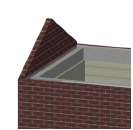 Creating wall components
Creating wall components Creating wall components
Creating wall componentsWall components define the sections that make up a standard wall. For example, to indicate that a wall is made up of studs, inner drywall, outer sheathing, and siding, define a component for each of these items to illustrate their location. Wall components can be offset at the top or the bottom of the wall, individually constrained relative to the wall, the layer, or, for Vectorworks Architect users, to story levels. Components can be textured, creating realistic section views and rendered views, as well as accurate wall supply estimates. If a material resource is used to define a component, the material typically provides the fill, texture, physical attributes, and construction information needed for drawings, renderings, and reports. The area and volume of wall components can be calculated in worksheets; see Worksheet functions.

The overall thickness of a wall is equal to the sum of its components. Component fill and pen style are only displayed in Top/Plan view (except for section viewports).
Wall components can be assigned to a class; this allows maximum flexibility since the component classes can be shown or hidden separately from the wall class. When a component is in an invisible class, its fill and lines are hidden. Invisible components on the interior and exterior of a wall cause the wall’s lines and fill to adjust to the visible components only, making the wall appear thinner than its actual width. This allows walls to show only their structural components, for example. If all components are invisible, the wall displays at its full thickness, without components. Set walls to display only visible components from the Object Info palette (see Wall properties).

The Auto-display detail levels for design layers preference can be used to show or hide wall components based on scale; see Hiding wall components.
Use the Eyedropper tool to copy wall component settings from one wall to another (see Transferring attributes).
Curtain walls do not have components.
|
Click here for a video tip about this topic (internet access required). |
To define a wall component:
1. Do one of the following:
● To define a component while a wall or wall style is being created, open the Definition tab of the Wall Preferences dialog box (see Drawing walls).
● To define or edit wall components for an existing, unstyled wall, or to edit the components’ top and bottom heights for styled walls, select the wall and click Components on the Object Info palette to open the Wall Components dialog box.
For a description of the parameters in the Wall Preferences dialog box or the Wall Components dialog box, see Standard wall preferences.
2.Below the Components list, click New to create a new component or select a component to edit and click Edit.
The Wall Component Settings dialog box opens. Specify the component thickness, name, and parameters.
 Click
to show/hide the parameters.
Click
to show/hide the parameters.
After you click OK, the wall’s Overall Thickness value changes to reflect the changes to the components. As components are defined, they display in the preview. Click and drag a component in the # column to change its order.
~~~~~~~~~~~~~~~~~~~~~~~~~